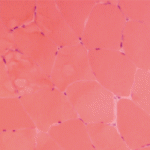Statins are frequently prescribed to patients in order to lower plasma low-density lipoprotein (LDL) concentrations and lower risk of cardiovascular disease. While generally considered to be safe, statins are associated with a small increased risk of clinical myopathy and type 2 diabetes. Up until now, there has been little scientific evidence to elucidate the mechanism behind statin’s effects on metabolism.
A new study suggests that the gene glycine amidinotransferase (GATM) may serve as the functional link between the ability of statins to lower cholesterol and their ability to cause statin-induced myopathy.1 GATM encodes the enzyme that is rate limiting in creatine synthesis. The phosphorylation of creatine is a major mechanism of energy storage in muscle.
Lara M. Mangravite, PhD, of Sage Bionetworks in Seattle, and colleagues published the results of their in vitro study in Nature. They analyzed individual gene transcription response to simvastatin treatment. Specifically, they used a “novel cell-based screen for gene-by-treatment” to examine the effects of statin on gene transcription.
“Here we identify a downstream target of statin treatment by screening for the effects of in vitro statin exposure on genetic associations with gene expression levels on lymphoblastoid cell lines derived from 480 participants of a clinical trial of simvastatin treatment,” the authors wrote in their abstract.
They found that simvastatin exposure had an effect on gene expression levels in 5,509 of 10,195 expressed genes. “We first identified eQTLs (expression quantitative trait loci) without considering whether they interact with simvastatin exposure. We computed Bayes factors to quantify evidence for the association between every single-nucleotide polymorphism (SNP) and the expression level of each gene, and we used permutations to estimate FDRs (false discovery rate). This analysis identified 4,590 genes with cis-QTLs, defined as eQTLs within 1 megabase (Mb) of the gene’s transcription start or end site (FDR=1%, log10 Bayes factor ≥3.24),” the authors wrote. They then used univariate association mapping and bivariate association mapping to identify eQTLs that interact with simvastatin exposure.
The authors found six loci (including GATM) that responded to simvastatin. In other words, statin exposure regulated GATM expression. This was true for a group of 51 SNPs within the GATM locus that are in linkage disequilibrium. “We found this locus [GATM] to be associated with the incidence of statin-induced myotoxicity in two separate populations,” wrote the authors.
The authors then utilized hepatocyte-derived cell lines and found that, when GATM was knocked down, the transcriptional response to sterol depletion was attenuated.


